"Outbreak of rage": since the invasion of Grenada, the Americans, for the first time after the Vietnam War, felt like a "world gendarme"
Little Island in the Caribbean
By the time of the American intervention in Grenada, this small island nation in the Caribbean had been nominally sovereign for nine years, having received 7 February 1974, independence from Great Britain. Discovered in 1498 by Christopher Columbus, the island of Grenada changed hands several times over the next centuries. In 1650, the island was acquired from its first owners, the Spanish crown, by the French, who increased their colonial presence in the West Indies. Administratively, Grenada was subordinated to the colonies of Martinique.
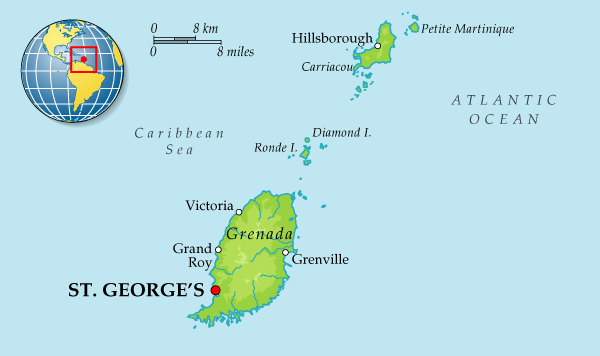
In the first five years of French rule, the new masters managed to completely destroy the indigenous inhabitants of Grenada - the Carib Indians, who were not adapted to slave labor on plantations. Plantation agriculture became the basis of the Grenadian economy. First of all, the French oriented the Grenada economic complex towards the cultivation and export of nutmeg, cocoa and indigo. To work on the plantations on the island began to deliver slaves from the coast of West Africa. So for three centuries, the population of Grenada for the most part began to make up the representatives of the Negroid race - blacks and mulattoes. At present, the negroes continue to make up more than 80% of the population of Grenada, another 13% is accounted for by mulattos and only about 5% of the Grenadians are represented by the British, French and other European nations.
It should be noted that the mixing of Spanish, French, English cultures with the traditions of African peoples, who came from Grenada as slaves, contributed to the formation of a unique folk culture on the island, combining heterogeneous elements and therefore of particular interest to ethnographers. First of all, the island of Grenada is bilingual. Despite the fact that English - the language of the former metropolis - remains the official language, the Creole dialect of French is also common among a large part of the island’s population. Despite the fact that the French colonial epic on the island ended 230 years ago, traces of French influence manifest themselves not only in the presence of Creole dialect and French borrowing in local English, but also in the influence of the Catholic religion on the island — more than half of the Grenadians profess it (54% of the population ). The remaining part of the population is Protestant, but it should be borne in mind that many black Grenadians have Christian denominations combined with Afro-Caribbean cults like voodooism, dating back to the animistic religions of West African peoples, primarily Yoruba. Thus, among the population of Grenada, the cult of the god Shango is still very widespread, and it also goes back to the Yorubian Orisha cult - the embodiment of the one god Olodumare. From the middle of the twentieth century, Rastafarianism, which originated in neighboring Jamaica, also became widespread in Grenada.
In the second half of the 18th century, the British became interested in Grenada, who had long vie with the Spaniards and the French for power over the islands of the Caribbean. In 1763, they managed to seize the island for a while, but in 1779, the French were once again entrenched in Grenada - not for long, as it turned out. In 1783, the Treaty of Versailles left the island behind Great Britain. Subsequent 190 years Grenada was part of the British colonial empire - first as part of the colony Leeward Islands (1885-1956), and then - as part of the West Indies Federation (1958-1962). During British rule, the main branch of the Grenada economy was the cultivation and export of nutmeg. In addition to nutmeg, Grenada grew and exported cocoa and bananas.
Like on the other islands of the West Indies, in Grenada since the first half of the twentieth century. began to spread the idea of autonomy of the island from the UK. By the end of 1950's and the British government itself provided for the possibility of granting political independence to Grenada. Initially it was planned to create the West Indies Federation as a forerunner of the sovereign association of English-speaking states of the West Indies, which would include Antigua, Barbados, Grenada, Dominica, Montserrat, St. Christopher and Nevis, St. Lucia, St. Vincent, Trinidad and Tobago and Jamaica. However, plans to form a united state of the West Indian Islands did not come true and in 1967, Grenada gained internal autonomy, and in 1974, its independence as a state within the British Commonwealth was proclaimed.
Independence, dictatorship and mongoose
However, the granting of independence to Grenada was not so much reflected in the standard of living of the local population (it became worse than in the colonial era), as it led to the growth of social and political contradictions in Grenadian society. The first leader of an independent Grenada was Eric Matthew Gary, who occupied the chair of the country's prime minister from 1974 to 1979. In his youth, Gayry was a psalm-reader of the Catholic Church, then he took up trade union activities and managed to visit many of the strikes of Grenadian workers in the 1940-1950-s.
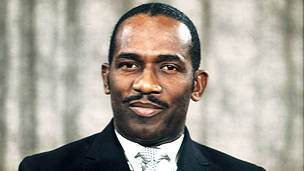 In 1951, Gary founded the United Labor Party of Grenada, officially considered Labor. In 1961-1962 and 1967-1974 Gayry served as the chief minister of the colony and the prime minister of the “associated state of Grenada”, respectively. After the independence of the country, he became its first prime minister. Despite the fact that all his political youth, Gary, was hiding behind the status of a labor union leader, having received the long-awaited post of prime minister, he did not fail to establish his own dictatorship on the island. Of course, Gary's dictatorship was not as cannibalistic as the Duvalier regimes in neighboring Haiti or the Somoz clan in Nicaragua, but the population of Grenada was literally brought to social outcry during the rule of the “black Labor”. There was enormous unemployment on the island, citizens were impoverished rapidly, able-bodied men went abroad in search of employment.
In 1951, Gary founded the United Labor Party of Grenada, officially considered Labor. In 1961-1962 and 1967-1974 Gayry served as the chief minister of the colony and the prime minister of the “associated state of Grenada”, respectively. After the independence of the country, he became its first prime minister. Despite the fact that all his political youth, Gary, was hiding behind the status of a labor union leader, having received the long-awaited post of prime minister, he did not fail to establish his own dictatorship on the island. Of course, Gary's dictatorship was not as cannibalistic as the Duvalier regimes in neighboring Haiti or the Somoz clan in Nicaragua, but the population of Grenada was literally brought to social outcry during the rule of the “black Labor”. There was enormous unemployment on the island, citizens were impoverished rapidly, able-bodied men went abroad in search of employment. Most of the income derived from agricultural exports, Prime Minister Gayry spent on the maintenance of the security forces and the army, relying on which he hoped to protect himself from the wrath of the Grenadians, whose wealth during his rule only worsened. But even the army with the police seemed little to the prime minister, the more he doubted their reliability. To defend his regime, Eric Gairy created, through his comrades-in-arms, troops under his control, known as "Mongoose Gang" - "Mongoose Gangs". History This name goes back to the 1950s, when the colonial administration fought the mongooses who harmed the island’s agriculture and hired special hunters who received money in exchange for proof of the killing of the mongoose — its tail. Often, the Mongoose gangs are compared to the Haitian Tonton Makutta, although the latter have done far more atrocities than their Grenadian counterpart. Nevertheless, both the British authorities and the powerful northwestern neighbor of Grenada - the United States of America - preferred to close their eyes to the abuses of Gary, since the latter did not hide his pro-American orientation.
On the other hand, in Grenada’s society itself, Gayrie’s policy was increasingly rejection. Socialist ideas were becoming more and more common among young socially active Grenadians, especially since revolutionary Cuba successfully built socialism in the neighborhood, orienting itself to the socialist path of development and many African states. Even before Grenada received official independence, in 1972, a new JUEL movement was created in the country - “Joint efforts in the field of social security, education and liberation”. Unison Whiteman and Maurice Bishop stood at its source. Ideologically, the movement adhered to radical leftist positions and advocated not only political, but also social liberation of Grenada.
In 1973-1979 continued political confrontation between the Grenadian socialists from the JUEL movement and the "mongooses" of Eric Gayry. The latter, sensing a serious threat to his power, began repressions against political opponents. 18 November 1973. JUEL leader Maurice Bishop and 9 his associates, who were going to the entrepreneurs' conference, were beaten by police, arrested and imprisoned. This day went down in the history of the country as “bloody Sunday”. 21 January 1974 a provocateurs, the Mongoose, attacked a mass demonstration in the Grenadian capital of St. George’s. Protesters were stoned, and the father of JUEL Maurice Bishop Rupert Bishop was shot with a rifle. After the “bloody Monday”, as JUEL activists dubbed this day, it was decided to focus on creating semi-legal movement cells in enterprises and plantations.
Maurice Bishop - Red Premier
In the process of fighting the dictator Gary's regime, Maurice Bishop (1944-1983) came to the fore in the political life of the island. This extraordinary man lived a very short, but decent and bright life. Maurice Bishop was born on the territory of the Aruba Island of the Netherlands in the family of a Grenadian migrant worker Rupert Bishop who worked in the oil fields. Six years after the birth of Maurice, his father Rupert returned with his family to Grenada, where he opened his own shop with the money he earned. Maurice was educated at a Catholic school, and then - at the Catholic College in St. Georges. Already during his college years, Maurice Bishop became interested in socialist ideas, primarily in the context of the struggle for the national and social liberation of African Americans and Afro-Caribs. Bishop’s worldview was influenced, on the one hand, by the works of African theorists, the Ghanaian leader Kwame Nkrumah and the Martinique revolutionary Frans Fanon, and on the other, by the Cuban revolution and its leaders Fidel Castro and Ernesto Che Guevara.
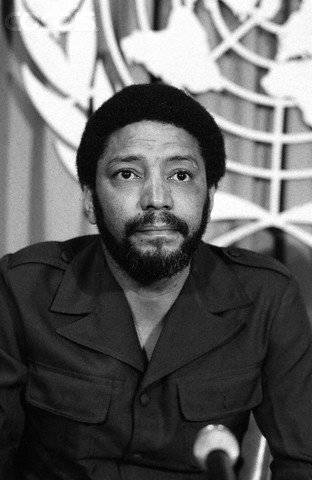 In 1963-1970 Maurice Bishop lived in the UK, where he studied at Holborn College at the University of London, and then worked as a lawyer in the legal aid society of the West Indian diaspora in London. It was during the years of his English studies that he finally became firmly established in his socialist convictions, having become acquainted with Marxism and Maoism, as well as various currents of "African socialism." Returning to Grenada in 1970, Bishop began to actively participate in political activities as a human rights activist first, and then as a leader of the socialist movement JUEL. In the middle of 1977, realizing that they could not succeed in replacing dictator Gayry by peaceful means, Bishop began preparations for a revolutionary coup and 13 in March 1979 of the year at the head of fifty armed comrades took over the country.
In 1963-1970 Maurice Bishop lived in the UK, where he studied at Holborn College at the University of London, and then worked as a lawyer in the legal aid society of the West Indian diaspora in London. It was during the years of his English studies that he finally became firmly established in his socialist convictions, having become acquainted with Marxism and Maoism, as well as various currents of "African socialism." Returning to Grenada in 1970, Bishop began to actively participate in political activities as a human rights activist first, and then as a leader of the socialist movement JUEL. In the middle of 1977, realizing that they could not succeed in replacing dictator Gayry by peaceful means, Bishop began preparations for a revolutionary coup and 13 in March 1979 of the year at the head of fifty armed comrades took over the country. After the revolutionary seizure of power, Maurice Bishop became the head of the People's Revolutionary Government, also receiving the posts of Minister of Defense, Internal Affairs, Security, Foreign Affairs, Information and Culture. Almost immediately, the Bishop government began reforming the Grenada social system with the aim of transferring it to the path of socialist development. First of all, modernization was expected by the agro-industrial complex. Inspired by the ideas of “communal ujmaa socialism” by Tanzanian President Julius Nyerere, Maurice Bishop set about developing the cooperative movement in agriculture, forming state farms as well. Serious support to Grenada in the modernization of the economy and social infrastructure was provided by neighboring Cuba. Thanks to Cuba, firstly, an international airport was built, and secondly, the construction of a fishing fleet Grenada. It was Maurice Bishop who owned the idea of developing the tourism sector in Grenada - the Prime Minister considered the island as a possible center for attracting poor tourists from Europe and the USA for an economical vacation on Grenada beaches. In addition to economic development, Bishop, realizing that internal and external enemies would always threaten the revolutionary authorities, proceeded to the construction of the Revolutionary Armed Forces of Grenada, in which neighboring Cuba also provided substantial support.
The successes of the revolutionary government of Bishop clearly show the numbers. During the four years of government, Maurice Bishop and his associates were able to solve the problem of food supply of the population of Grenada, to create a free health care system that was absent during the colonial period. The most serious step of the new government was the elimination of illiteracy of the population - the number of illiterate people was reduced from 35% of the citizens of Grenada to 5%. Similarly, by attracting to work in state farms and starting construction of infrastructure facilities, the number of unemployed has significantly decreased. If during the reign of Gary more than 50% of the inhabitants of Grenada had no work, then under the Bishop government there were only 14%.
Naturally, the political and economic transformations carried out in Grenada were not to the liking of the United States. Initially, the Americans decided to act using proven methods - through sabotage and provocation. 19 June 1980 sounded an explosion at the first military parade in the history of Grenada. The goal of the terrorist act was to be the leaders of the revolutionary state, but they managed to escape. But innocent 13 girls and 23 years died. After the explosion, Maurice Bishop spoke on the radio, openly accusing the United States Central Intelligence Agency of preparing and carrying out a terrorist act. Thus began the dramatic story of the confrontation of tiny Grenada and the "world gendarme" of the United States.
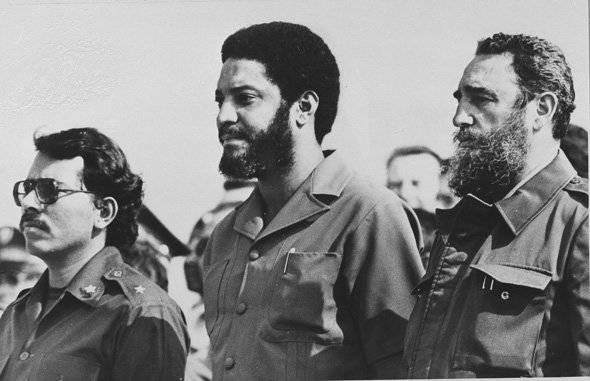
The American leadership was very much afraid of the creation of a communist regime in Grenada - the second after Cuba on the islands of the Caribbean. The situation for the USA was complicated by the fact that the Sandinistas came to power in the same time period in Nicaragua, the communist partisans became more active in El Salvador and Colombia. In order to prevent the “second Cuba” from appearing under the American security forces were ready for anything. In addition to "political and economic measures", which consisted in evading trade with Grenada and providing loans to the Bishop government, the United States did not rule out the possibility of an armed invasion of Grenada. Moreover, the circumstances for the implementation of the latter plan were very favorable.
By 1983, a rather influential left-wing opposition headed by Deputy Prime Minister Bernard Cord (R.N.XX), which was even more revolutionary than Bishop, was formed in the New Year JUEL movement. Bernard Cord, who received a political scientist degree, in his youth was a member of the US Communist Party and the British Communist Party, and then took part in the coming of the JUEL movement to power in Grenada and took the post of finance minister and then vice-premier.
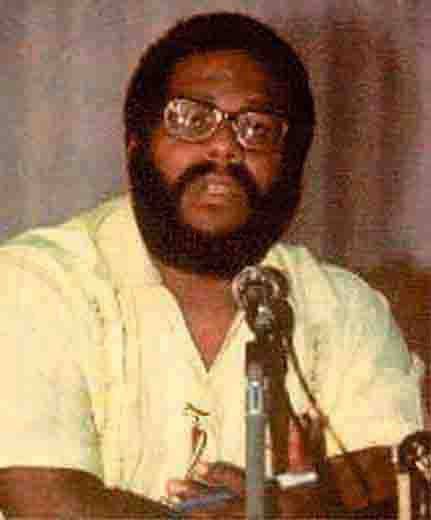
Taking more radical positions than Bishop, Kord insisted on reproducing the Cuban and Nicaraguan experience of political organization on the island and completely severing relations with the "American imperialists." In turn, Maurice Bishop feared open confrontation with the United States, realizing that he could hardly defend the political sovereignty of Grenada in this case.
When US naval forces conducted naval exercises off the coast of Grenada in March, Bishop, who was trying to prevent an armed clash with an overwhelming enemy, flew to the USA, where he met with the presidential aide for national security and promised to abandon close cooperation with Cuba . This manifestation of the political moderation of the Grenadian leader did not please his radical supporters, who saw in the US visit a betrayal of the ideals of the national revolution. October 1983 12, the year Bishop was placed under house arrest. This decision of the leadership of the Central Committee of the New Movement JUEL caused a sharp discontent of a part of the Grenadian population, among which Maurice Bishop enjoyed great popularity. October 1983 19, Bishop's supporters led by Unison Whiteman and Vincent Noel, released the arrested prime minister.
The rebels, led by Bishop, entrenched themselves in the Fort Rupert captured by them, where the headquarters of the Revolutionary Armed Forces was located. The commandant of the fort, Major Christopher Strood, did not obstruct the insurgents. In response, the leaders of the Central Committee of the New Movement JUEL sent a company of Revolutionary Armed Forces to storm the Fort. Bishop, along with ten colleagues, including his pregnant wife, Jacqueline Kreft, was captured and shot. October 19 The Grenada government was dissolved, and all power was transferred to the Revolutionary Military Council, which was led by General Hudson Austen. The new leader of Grenada appealed, in which he announced the transfer of power to the Revolutionary Military Council and the continuation of further struggle against the imperialist threat from the United States and the pro-American “fifth column” inside Grenada.
"Outbreak of rage" "American psychopaths"
Almost immediately after the revolutionary coup, the command of the American armed forces began preparations for the invasion of Grenada. The upcoming operation was called "Flash of Fury." To participate in the operation, the United States of America brought in 5 landing and tank landing ships, the 22nd Marine Regiment, two brigade groups of the Airborne Forces, special forces units of the Navy and ground forces, engineering, rear and radio technical units, and an army regiment aviation, seven aviation regiments of the Air Force. Vice Admiral Joseph Metcaff, Commander of the 2nd Operational Fleet of the US Navy, was appointed to lead the group, and Major General Norman Schwarzkopf directly supervised the ground forces. The total number of troops preparing for landing in Grenada of the American army was more than 7300 troops, plus 353 soldiers and officers sent by Jamaica and Barbados. The rest of the Caribbean, following in foreign policy in the wake of the United States, fully supported the planned operation to "establish democracy."
October 25 1983, Operation Outbreak of Rage began. The formal reason for the invasion was the alleged seizure of American students hostage. There were indeed 630 students at the University of St. George’s and several campuses, but no one was going to take them hostage and harm them. American President Ronald Reagan’s concern for the safety of American students was used solely as a pretext for armed aggression against sovereign Grenada. By the time the American troops landed on the island, the Revolutionary Armed Forces of Grenada had only 1 thousand troops in the infantry battalion of constant combat readiness and five cropped infantry battalions. Heavy weapons from the Grenada people's army were completely absent, the exception was ten Soviet BTR-60 and two BRDM-2. The Cuban builders, who were on the island in the strength of about 800 people and who, like all Cubans, had the skills of military training, could render the feasible help to the Grenadian revolutionaries. Naturally, it was not difficult for the American troops to be many times superior in numbers and armament to crush the resistance of the Grenadian army and Cuban builders armed only with small arms. weapons, and by October 27 1983, two days after the start, Operation Rage Outbreak was completed.
According to official data, 19 US troops died during the operation. For a long time, the data on the course of the operation were kept secret and only lately have more details come up that cast doubt on the actual combat effectiveness of the “world gendarme” even compared to such a tiny country like Grenada. According to modern data, during the operation, soldiers and officers of the Grenadian people's army shot down around 100 American transport helicopters. Accordingly, we can talk not about 19 dead, but at least two thousand American soldiers and officers who were on the downed helicopters. Given that all the armed forces of Grenada numbered 1 a thousand people, and there was no air defense on the island (except for a few Soviet 61-K 1939 anti-aircraft cannons of the year), these figures look quite impressive. Although, of course, for obvious reasons, the Grenadians failed, unfortunately, to defend their island from the attack of the American army.
October 29 1983, the United States of America lifted all economic sanctions against Grenada and pledged to pay 110 million dollars to the island for further economic development. The revolutionary government in Grenada ceased to exist and the island, after a four-year socialist experiment, returned to the position of a political and economic semi-colony. A contingent of US forces remained on the island until 1985, ensuring the “safety of free elections,” which in December 1984 won, of course, the pro-American liberal coalition led by Herbert Blazes. Representatives of the revolutionary government of Grenada were arrested and sentenced to death in 1986 for murder of Maurice Bishop, after which the execution was replaced by life imprisonment. Among those arrested were members of the Central Committee of the New Movement JUEL, as well as officers of the Grenadian army who were directly involved in the arrest and execution of Bishop - Captain Lester Redhead, Major Christopher Stroud, Senior Lieutenant Cecil Prime and Lieutenant Callistus Bernard, who directly commanded the firing squad. It was only in 2007, that General Hudson Austin and his associates, Colville Macbarnett and John Venture, managed to break free. After another two years, in 2009, the 60-year-old Bernard Kord, who was considered the initiator of the left-radical coup 13-14 of October 1983, was released.
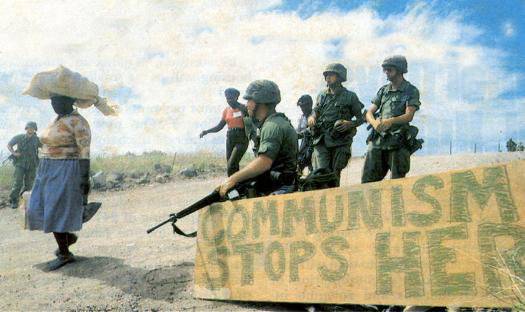
From the history of the armed invasion of Grenada, a new period of strengthening the positions of the United States of America began. If, after the shameful defeat in Indochina, which ended with the emergence of "red" Vietnam, Laos and Cambodia, the Americans preferred to refrain from armed adventures outside their territory, then the success of the "Outbreak of Rage" inspired the US to new outrages. Moreover, the States realized that the decrepit Soviet Union was no longer able to fully resist the growing American expansion. Following the “Outbreak of Rage” followed air strikes on Libya, operations in the Persian Gulf, Somalia, and after the collapse of the Soviet Union, the States finally let loose, feeling like the sole owner of the global situation and using military force at their own discretion against all politically undesirable states.
Information